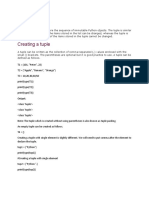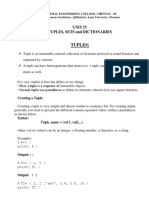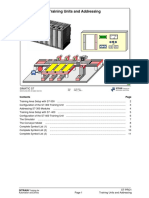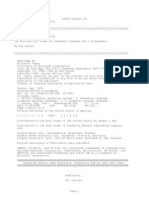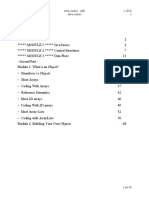Python 04uple
Uploaded by
jaskirat singh chughPython 04uple
Uploaded by
jaskirat singh chughTuple
A tuple is a collection which is ordered and unchangeable. In Python tuples
are written with round brackets.
Create a tuple
thistuple = ("apple", "banana", "cherry")
print(thistuple)
Output :
('apple', 'banana', 'cherry')
NOTE:- Indexing of tuple is just similar to indexing of list
Access Tuple Items
You can access tuple items by referring to the index number, inside square
brackets:
Return the item in position 1:
thistuple = ("apple", "banana", "cherry")
print(thistuple[1]) # returns banana
print ("thistuple[1:2]: ",thistuple[1:2]) # returns banana cherry
Output :
Change Tuple Values
Once a tuple is created, you cannot change its values. Tuples
are unchangeable.
Example
You cannot change values in a tuple:
thistuple = ("apple", "banana", "cherry")
thistuple[1] = "blackcurrant"
Python Chapter-04 Page 1
# The values will remain the same:
print(thistuple)
Loop Through a Tuple
You can loop through the tuple items by using a for loop.
Iterate through the items and print the values:
thistuple = ("apple", "banana", "cherry")
for x in thistuple:
print(x)
Output :
apple
banana
cherry
Check if Item Exists
To determine if a specified item is present in a tuple use the in keyword:
Check if "apple" is present in the tuple:
thistuple = ("apple", "banana", "cherry")
if "apple" in thistuple:
print("Yes, 'apple' is in the fruits tuple")
Output :
Yes, 'apple' is in the fruits tuple
Add Items
Once a tuple is created, you cannot add items to it. Tuples
are unchangeable.
You cannot add items to a tuple:
thistuple = ("apple", "banana", "cherry")
thistuple[3] = "orange" # This will raise an error
print(thistuple)
Python Chapter-04 Page 2
Remove Items
Note: You cannot remove items in a tuple.
Tuples are unchangeable, so you cannot remove items from it, but you can
delete the tuple completely:
The del keyword can delete the tuple completely:
thistuple = ("apple", "banana", "cherry")
del thistuple
print(thistuple) #this will raise an error because the tuple no
longer exists
Adding two tuples
Tuples are immutable,that’s why we can’t change the content of tuple.It’s alternate way is to
take contents of existing tuple and create another tuple with these contents as well as new
content.
E.g. tup1 = (1, 2)
tup2 = ('a', 'b')
tup3 = tup1 + tup2
print (tup3)
Output (1, 2, 'a', 'b')
Delete Tuple Elements
Direct deletion of tuple element is not possible but shifting of required content after discard of
unwanted content to another tuple.
e.g. tup1 = (1, 2,3)
tup3 = tup1[0:1] + tup1[2:]
print (tup3)
Output (1, 3)
Tuple Methods
Python Chapter-04 Page 3
Python has two built-in methods that you can use on tuples.
(a) Count – Returns the number of times a specified value occurs in a tuple
thistuple = (1, 3, 7, 8, 7, 5, 4, 6, 8, 5)
x = thistuple.count(5)
print(x)
Output : 2
(b) index - Searches the tuple for a specified value and returns the position
of where it was found.
Search for the first occurrence of the value 8, and return its position:
thistuple = (1, 3, 7, 8, 7, 5, 4, 6, 8, 5)
x = thistuple.index(8)
print(x)
Output : 3
(c) len () - To determine how many items a tuple has, use
the len() method:
Print the number of items in the tuple:
thistuple = ("apple", "banana", "cherry")
print(len(thistuple))
Output : 3
(d) max - returns the maximum element in a tuple
Example:
Tuple = (456,700,200)
Print (“maximum value “, max(tuple))
(e) min - returns the minimum element in a tuple
Example:
Tuple = (456,700,200)
Print (“minimum value “, min(tuple))
Search an element in tuple without using membership operator
Python Chapter-04 Page 4
thistuple = ("apple", "banana", "cherry")
l = len(thistuple)
f = 1
for x in range(l):
if thistuple[x] == "cherry":
f = 1
if f ==1 :
print("Yes, 'apple' is in the fruits tuple")
else:
print("No, 'apple' is in the fruits tuple")
Adding element in tuple using List
Python tuple is an immutable object. Hence any operation that tries to modify it (like append) is not allowed.
However, following workaround can be used.
First, convert tuple to list by built-in function list(). You can always append item to list object. Then use
another built-in function tuple() to convert this list object back to tuple.
>>> T1=(10,50,20,9,40,25,60,30,1,56)
>>> L1=list(T1)
>>> L1
[10, 50, 20, 9, 40, 25, 60, 30, 1, 56]
>>> L1.append(100)
>>> T1=tuple(L1)
>>> T1
(10, 50, 20, 9, 40, 25, 60, 30, 1, 56, 100)
You can see new element appended to original tuple representation.
Exercises
1. Write a Python program to create a tuple.
2. Write a Python program to create a tuple with different data types.
3. Write a Python program to create a tuple with numbers and print one item.
4. Write a Python program to add an item in a tuple.
5. Write a Python program to get the 4th element and 4th element from last of a tuple.
6. Write a Python program to find the repeated items of a tuple.
7. Write a Python program to check whether an element exists within a tuple.
8. Write a Python program to convert a list to a tuple.
9. Write a Python program to remove an item from a tuple.
Python Chapter-04 Page 5
10. Write a Python program to slice a tuple.
11. Write a Python program to find the index of an item of a tuple.
12. Write a Python program to find the length of a tuple.
13. Write a Python program to reverse a tuple.
14. Write a Python program to sort a tuple .
Practice questions
1. What is the output of print tuple * 2 if tuple = (123, ‘FREYA’)?
2. What Will Be The Output Of The Following Code Snippet?
tuple_a = 1, 2
tuple_b = ('3', '4')
print (tuple_a + tuple_b)
3. What Will Be The Output Of The Following Code Snippet?
tuple_a = 1, 2
tuple_b = (3, 4)
r=[sum(x) for x in [tuple_a + tuple_b]]
print(r)
4. Which Of The Following Statements Given Below Is/Are True?
A. Tuples have structure, lists have an order.
B. Tuples are homogeneous, lists are heterogeneous.
C. Tuples are immutable, lists are mutable.
D. All of them.
5. What Will Be The Output Of The Following Code Snippet?
tuple = ('Python') * 4
print(type(tuple))
6. What Will Be The Output Of The Following Code Snippet?
tuple = (1,) * 3
tuple[0] = 2
print(tuple)
7. What will be the output?
t=(11,121,14,13)
print(t[1:3])
8. What will be the output?
t = (11, 12, 14, 13, 18, 19)
r=[t[i] for i in range(0, len(t), 2)]
print(r)
9. What will be the output?
t1 = (1, 2, 3, 3)
t2 = (1, 2, 3, 4)
print(t1 < t2)
Python Chapter-04 Page 6
10. What will be the output?
a=(2,3,4)
print( sum(a,3))
11. What is the output of the following piece of code?
a=(0,1,2,3,4)
b=slice(0,2)
print(a[b])
12. How we can compare items of two tuples?
Python Chapter-04 Page 7
You might also like
- Python Notes 11 Dictionary Tuples and Sets 1664121924No ratings yetPython Notes 11 Dictionary Tuples and Sets 166412192421 pages
- FALLSEM2024-25_BCSE101E_ETH_CH2024250103610_Reference_Material_I_06-09-2024_Tuples_06-09-2024No ratings yetFALLSEM2024-25_BCSE101E_ETH_CH2024250103610_Reference_Material_I_06-09-2024_Tuples_06-09-202441 pages
- U18CSI2201 - Unit 4 Tuples and Dictionaries 1No ratings yetU18CSI2201 - Unit 4 Tuples and Dictionaries 161 pages
- Tuples: 'Physics' 'Chemistry' "A" "B" "C" "D" "E"No ratings yetTuples: 'Physics' 'Chemistry' "A" "B" "C" "D" "E"7 pages
- Fill in The Blanks With Correct Family MembersNo ratings yetFill in The Blanks With Correct Family Members1 page
- 5G-Smart Diabetes Toward Personalized Diabetes Diagnosis With Healthcare Big Data CloudsNo ratings yet5G-Smart Diabetes Toward Personalized Diabetes Diagnosis With Healthcare Big Data Clouds8 pages
- Signal Phase Timing Impact On Traffic Delay and Queue Length-A Intersection Case StudyNo ratings yetSignal Phase Timing Impact On Traffic Delay and Queue Length-A Intersection Case Study2 pages
- MA400: Financial Mathematics: Introductory Course100% (1)MA400: Financial Mathematics: Introductory Course24 pages
- "HATRED Ultralite Frame Board" Instruction Manual: Software Revision 3No ratings yet"HATRED Ultralite Frame Board" Instruction Manual: Software Revision 32 pages
- Francisco Cruz Java Course - Edx:) 2018 Francisco Cruz Java Course:)No ratings yetFrancisco Cruz Java Course - Edx:) 2018 Francisco Cruz Java Course:)56 pages
- Flash MX Savvy 1st Edition by ISBN instant download100% (4)Flash MX Savvy 1st Edition by ISBN instant download43 pages
- L-26 - Client-Centric Consistency Models - Saurabh JhaNo ratings yetL-26 - Client-Centric Consistency Models - Saurabh Jha10 pages
- Managerial Accounting: The Cornerstone of Business Decision-Making 7th Edition Maryanne M. Mowen all chapter instant download100% (3)Managerial Accounting: The Cornerstone of Business Decision-Making 7th Edition Maryanne M. Mowen all chapter instant download41 pages
- CDNetworks Web Application Firewall Product BrochureNo ratings yetCDNetworks Web Application Firewall Product Brochure2 pages
- 06 Scaling With Google Cloud OperationsNo ratings yet06 Scaling With Google Cloud Operations13 pages
- Small-Molecule Library Screening by Docking With Pyrx: Sargis Dallakyan and Arthur J. OlsonNo ratings yetSmall-Molecule Library Screening by Docking With Pyrx: Sargis Dallakyan and Arthur J. Olson8 pages
- Introduction To Software Engineering PDFNo ratings yetIntroduction To Software Engineering PDF451 pages
- Types of Technologies TTL Demo Group 12 - 120304No ratings yetTypes of Technologies TTL Demo Group 12 - 12030423 pages
- Lithium Battery Application Guide (Hybrid Use Scenario) : Panel and PortsNo ratings yetLithium Battery Application Guide (Hybrid Use Scenario) : Panel and Ports9 pages



